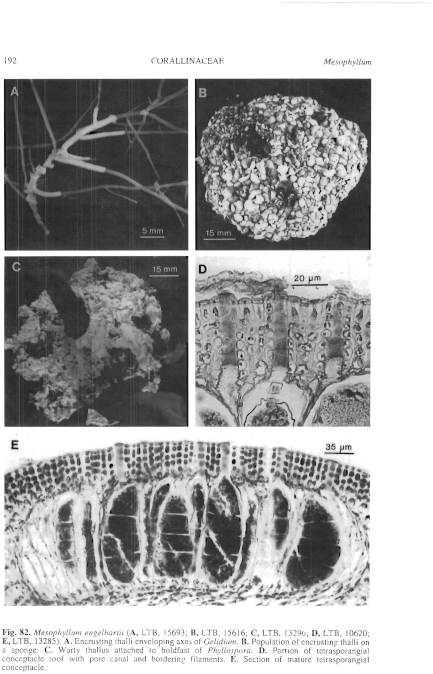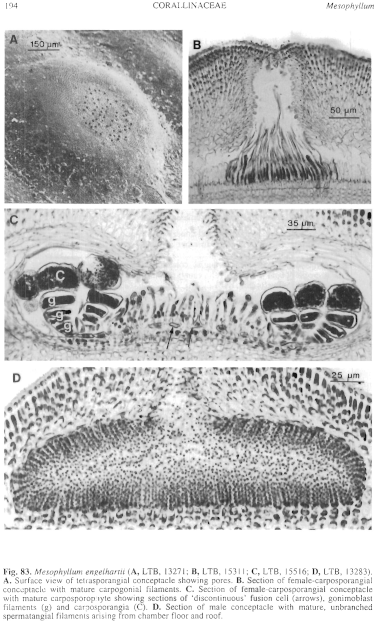|
|
|
|
|
|||||||||||
|
Electronic Flora of South Australia Species Fact Sheet
Phylum Rhodophyta – Class Florideophyceae – Order Corallinales – Family Corallinaceae – Subfamily Melobesioideae
Selected citations: Barry & Woelkerling 1995: 143. Woelkerling & Harvey 1993: 581, figs 1–11. Chamberlain & Keats 1995: 134, figs 1–51.
Synonyms
Lithothamnion engelhartii Foslie 1900a: 18. Printz 1929: 40, pl. 7 figs 12–14 (as f. typica). Woelkerling 1993: 84.
Lithothamnion engelhartii f. imbricata Foslie 1900a: 19. Woelkerling 1993: 120.
Lithothamnion engelhartii f. umbonata Foslie 1900a: 18. Woelkerling 1993: 230.
Lithothamnion patena f. engelhartii (Foslie) Heydrich 1907: 223 (as engelhartii).
Lithothamnion discrepans Foslie 1907b: 8. Chamberlain & Keats 1995: 141, figs 5, 36–45.
Lithothamnion fumigatum Foslie 1901a: 7. Woelkerling 1993: 100.
Lithothamnion lemniscatum Foslie 1907b: 11. Woelkerling 1993: 137.
Lithothamnion speciosum (Foslie) Foslie 1907b: 16.
Lithothamnion synanablastum f. speciosa Foslie 1900a: 18. Chamberlain & Keats 1995: figs 4, 7, 12, 46–51.
Lithothamnion versicolor Foslie 1907a: 3. Woelkerling 1993: 236.
Additional references involving these and other binomials, previous southern Australian records, misapplied names and known heterotypic synonyms are given by Woelkerling & Harvey 1993. Further references are given by Chamberlain & Keats 1995.
Thallus normally pinkish, encrusting to warty, layered or foliose, mostly 6–85 mm across and 0.05–22 mm thick or tall, epigenous and partially to completely ventrally affixed by cell adhesion; protuberant branches erect, mostly simple, 1–4 mm in diameter and 2.3–10 mm long; lamellate branches applanate or ascending, sometimes interwoven, simple or furcate, mostly 3–10 mm across and 5–16 mm long. Structure pseudoparenchymatous; organisation dorsiventral in crustose portions and lamellate branches but radial in protuberant branches; construction monomerous, consisting of a single system of branched, laterally cohering, filaments that collectively contribute to a ventrally or centrally situated core and a peripheral region where portions of core filaments or their derivatives curve outwards towards the thallus surface, each filament composed of cells 3–19 µm in diameter and 9–33 µm long; epithallial cells 3–5 µm in diameter and 4–9 µm long, terminating most filaments at the thallus surface, with distal walls rounded or flattened but not flared; cell elongation occurring mainly within actively dividing subepithallia/ initials that are usually as long as or longer than their immediate inward derivatives; cells of adjacent filaments joined by cell-fusions; secondary pit-connections, haustoria, and trichocytes unknown.
Reproduction: Vegetative reproduction unknown. Gametangia and carposporophytes produced in uniporate conceptacles; tetrasporangia and bisporangia produced in multiporate conceptacles.
Gametangial thalli monoecious or dioecious; carpogonia and spermatangia produced in separate conceptacles. Carpogonia terminating 2–4-celled filaments arising from the female conceptacle chamber floor. Mature female-carposporangial conceptacle roofs protruding above surrounding thallus surface, 100–180 µm thick, composed of 13–38 layers of cells above the chamber, conceptacle chambers 185–500 µm in diameter and 45–230 µm high. Carposporophytes lacking a conspicuous central fusion cell and apparently consisting of an irregularly shaped fusion cell (not always evident) that may look discontinuous in section or a several-celled fusion cell complex (evident only in young stages), and several-celled gonimoblast filaments bearing terminal carposporangia 30–95 µm in diameter. Spermatangial filaments unbranched, arising from the floor, walls and roof of male conceptacle chambers, mature male conceptacle roofs protruding above surrounding thallus surface, (32–) 40–55 (–135) µm thick, composed of 6–16 layers of cells above the chamber, conceptacle chambers (54–) 108–175 (–284) µm in diameter and 20–110 µm high.
Tetrasporangial/bisporangial conceptacle roofs protruding above surrounding surface, not differentiated into a peripheral rim and a central sunken pore-plate, 3–10 cells thick above the chamber, pore canals lined by cells that are similar in size and shape to other roof cells, conceptacle chambers 160–500 µm in diameter and 65–260 µm high; tetrasporangia scattered across the conceptacle chamber floor, each mature sporangium 24–81 µm in diameter and 59–173 µm long, containing zonately arranged tetraspores and possessing an apical plug that blocks a roof pore prior to spore release; bisporangia occasional, 22–65 µm in diameter and 68–110 µm long.
Type from Cape Jaffa, S. Aust.; lectotype in TRH (unnumbered; includes slide 350); designated by Adey in Adey & Lebednik (1967, p. 69); depicted in Printz (1929, pl. 7 fig. 14) and in Woelkerling & Harvey (1993, p. 607, fig. 1A); additional data provided by Woelkerling (1993, p. 84).
Selected specimens: Eagle Bluff, Shark Bay., W. Aust., upper sublittoral (Woelkerling, 31.vii.1986; LTB, 15482, 15486). Mabel Cove, Rottnest I., W. Aust., reef top (Woelkerling, 9.ii.1978; LTB, 10640, 10643). Jeannies Lookout, Rottnest I., W. Aust., 1–3 m deep (Woelkerling, 12.ii.1978; LTB, 10620, 10628). Lucky Bay, Cape Le Grand National Park, W. Aust., 0–3 m deep (Woelkerling, Platt & Jones, 9.ii.1984; LTB, 14333). Eyre (Nine Mile Reef), W. Aust., 2–3 m deep (Woelkerling, Platt & Jones, 1.ii.1984; LTB, 13970). Point Fowler (east shore), S. Aust., 2–3 m deep (Plan & Jones, 14.ii.1984; LTB, 14471). Point Westall, S. Aust., 2–3 m deep (Platt & Jones, 16.ii.1984; LTB, 14535). Snug Cove, Kangaroo I., S. Aust., 10–13 m deep (Campbell & Penrose, 12.iv.1988; LTB, 15616, 15617). Beachport (Post Office Rock), S. Aust., reef top (Campbell, Penrose & Woelkerling, 1.xii.1986; LTB, 15516). Beachport, S. Aust., 3–6 m deep (Campbell & Penrose, 26.ii.1988; LTB, 15693). Anglesea (Ingoldsby Reef), Vic., 0.5 m deep (Beanland, 19.i.1983; LTB, 13550). Rye (Number Sixteen reef), Vic., reef pools (Woelkerling, 31.iii.1985; LTB, 14759). Kitty Miller Bay, Phillip I., Vic., 1–2 m deep (Woelkerling, Campbell & Penrose, 2.xii.1985; LTB, 15311). Bluestone Bay, Freycinet Pen., Tas., 0–6 m deep (Platt & Woelkerling, 26.ii.1983; LTB, 13296). Eaglehawk Neck (Clydes I.), Tas., 0–6 m deep (Woelkerling & Plan, 26.ii.1983; LTB 13275, 13285 and Plan & Woelkerling, 26.ii.1983; LTB, 13270, 13271, 13283). Ninepin Point, D'Entrecasteaux Channel, Tas., 4–6 m deep (Platt & Brown, 18.ii.1983; LTB, 12734, 12752, 12753). Variety Bay (S shore), Bruny I., Tas., 2–4 m deep (Platt, Woelkerling & Brown, 17.ii.1983; LTB, 12936, 12950, 12951).
Distribution: Eagle Bluff, Shark Bay, W. Aust., to Kitty Miller Bay, Phillip I., Vic., and the eastern and southern coasts of Tasmania.
New Zealand, Auckland Islands; South Africa; Namibia.
Taxonomic notes: Mesophyllum engelhartii has been found intertidally on reef edges and in pools, and subtidally to depths of 15 m in southern Australia. Thalli occur on rock, molluscs, sponges and various green, brown, and red algae. In epiphytic and epizoic collections, dozens of individuals commonly occur on a single host and gametangial, tetrasporangial and bisporangial specimens are often present. Tetrasporangial conceptacle anatomy is very similar in Mesophyllum engelhartii and Synarthrophyton patena, and certain tetrasporangial thalli of the two species could be confused if viewed in isolation (A. Harvey et al. 1994, p. 341). Male thalli, however, can easily be told apart as spermatangial branches are unbranched in Mesophyllum engelhartii but branched in Synarthrophyton patena. Chamberlain & Keats (1995) provide a detailed account of the species in South Africa.
References:
ADEY, W.H. & LEBEDNIK, P.A. (1967). Catalog of the Foslie Herbarium. (Det Kongelige Norske Videnskabers Selskab Museet: Trondheim, Norway.)
ADEY, W.H. (1970). A revision of the Foslie crustose coralline herbarium. K. norske Vidensk. Selsk. Skr. 1970 (1), 1–46.
BARRY, G.C. & WOELKERLING, W.J. (1995). Non-geniculate species of Corallinaceae (Corallinales, Rhodophyta) in Shark Bay, Western Australia: biodiversity, salinity tolerances and biogeographic affinities. Botanica Mar. 38, 135–149.
CHAMBERLAIN, Y.M. & KEATS, D.W. (1995). The melobesioid alga Mesophyllum engelhartii (Rhodophyta, Corallinaceae) in South Africa. S. Afr. J. Bot. 61, 134–146.
FOSLIE, M. (1900a). New or critical calcareous algae. K. norske Vidensk. Selsk. Skr. 1899(5), 1–34.
FOSLIE, M. (1901a). New melobesieae. K. norske Vidensk. Selsk. Skr. 1900(6), 1–24.
FOSLIE, M. (1907a). Algologiske notiser. III. K. norske Vidensk. Selsk. Skr. 1906(8), 1–34.
FOSLIE, M. (1907b). Algologiske notiser. IV. K. norske Vidensk. Selsk. Skr. 1907(6), 1–30.
HARVEY, A.S., WOELKERLING, W.J. & WILKS, K.M. (1994). The genus Synarthrophyton (Corallinaceae, Rhodophyta) in southern Australia. Phycologia 33, 331–342.
HEYDRICH, F. (1907). Über Sphaeranthera lichenoides (El 1 . et Sol.) Heydr. mscr. Beih. bot. Zbl. 22, 222–230, Plates 10, 11.
PRINTZ, H. (1929). M. Foslie — &lsquot;Contributions to a Monograph of the Lithothamnia&rsquot;. K. Norske Vidensk. Selsk. Skr. Museet, Trondhjem. 60 pp. 75 Plates.
WOELKERLING, W.J. & HARVEY, A. (1993). An account of sourthern Australian species of Mesophyllum (Corallinaceae, Rhodophyta). Aust. Syst. Bot. 6, 571–637.
WOELKERLING, Wm.J. (1993). Type collections of Corallinales (Rhodophyta) in the Foslie Herbarium (TRH). Gunneria 67, 1–289.
The Marine Benthic Flora of Southern Australia Part IIIB complete list of references.
Publication:
Womersley, H.B.S. (28 June, 1996)
The Marine Benthic Flora of Southern Australia
Rhodophyta. Part IIIB. Gracilarialse, Rhodymeniales, Corallinales and Bonnemaisoniales
Reproduced with permission from The Marine Benthic Flora of Southern Australia Part IIIB 1996, by H.B.S. Womersley. Australian Biological Resources Study, Canberra. Copyright Commonwealth of Australia.
Illustrations in Womersley Part IIIA, 1996: FIGS 82, 83.

Figure 82 enlarge
Fig. 82. Mesophyllum engelhartii (A, LTB, 15693; B, LTB, 15616; C, LTB, 13296; D, LTB, 10620; E, LTB, 13285). A. Encrusting thalli enveloping axes of Gelidium. B. Population of encrusting thalli on a sponge. C. Warty thallus attached to holdfast of Phyllospora. D. Portion of tetrasporangial conceptacle roof with pore canal and bordering filaments. E. Section of mature tetrasporangial conceptacle.

Figure 83 enlarge
Fig. 83. Mesophyllum engelhartii (A, LTB, 13271; B, LTB, 15311; C, LTB, 15516; D, LTB, 13283). A. Surface view of tetrasporangial conceptacle showing pores. B. Section of female-carposporangial conceptacle with mature carpogonial filaments. C. Section of female-carposporangial conceptacle with mature carposporophyte showing sections of 'discontinuous' fusion cell (arrows), gonimoblast filaments (g) and carposporangia (C). D. Section of male conceptacle with mature, unbranched spermatangial filaments arising from chamber floor and roof.

|
Email Contact: State Herbarium of South Australia |

|